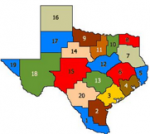Federal education laws, like the Perkins Act, are interpreted and implemented at the local level through state governments, agencies, and school districts. The Perkins Act
of 2006 allows for state and local flexibility in providing services and activities designed to develop, implement, and improve career and technical education. Consequently, each state administers CTE differently.
Texas Legislature
In Texas, the administrative structure of CTE starts with the State Legislature which is responsible for writing and passing bills that are signed into law by the governor. Education bills passed into law are incorporated into the Texas Education Code. Bills impacting Career and Technical Education are found in other parts of the Texas government code as well, because the focus of the law is more on industry or workforce issues rather than public education.
State Board of Education
The State Board of Education (SBOE) and the Commissioner of Education have the authority to adopt rules and establish policies to further clarify State laws regarding the Texas public education system. These rules are found in the Texas Administrative Code.
The SBOE is a 15-member elected body. It serves as the State Board for Career and Technical Education and is responsible for CTE and the administration of the Carl D. Perkins Career and Technical Education Act of 2006.
Texas Education Agency
The Texas Education Agency (TEA) is the state's administrative unit for primary and secondary public education. It is headed by the Commissioner of Education who is appointed by the governor. TEA is the designated agency for the management and disbursement of Perkins funding for CTE.
Together, the State Board of Education, the Commissioner of Education, and the TEA staff provide leadership, guidance, and resources to help meet the educational needs of all Texas students.
State Board for Educator Certification
The State Board for Educator Certification (SBEC) was created by the Texas Legislature in 1995 to recognize public school educators as professionals and give them authority to govern the standards of their profession. SBEC oversees all aspects of the preparation, certification and standards of conduct of public school educators.
Texas Higher Education Coordinating Board
The Texas Higher Education Coordinating Board (THECB) provides leadership and coordination for the Texas higher education system. THECB receives Perkins funding to support postsecondary career and technical education programs. The State Board of Education determines the funding split between TEA and THECB based on an analysis of program data and other quantitative information. The SBEC currently allocates 70 percent of Perkins funding toward secondary education and 30 percent to postsecondary education.
School Districts
School boards are locally elected trustees responsible for interpreting and implementing education laws and rules for their district. The board of trustees of a school district, or the governing body of an open-enrollment charter school, has primary responsibility for ensuring compliance with all requirements of state educational programs. School boards may adopt rules, such as local policies and procedures, and bylaws necessary to carry out the powers and duties of the local education agency.
| Local Education Agency (LEA) can refer to a public school district, or, in rural areas, a body that oversees multiple schools. The responsibilities of a LEA may include operating the public school system, distributing grant money to school projects, and contracting for educational services. The LEA system is important because it allows each community to have an agency that responds to the local educational issues of that community. |
In Texas there are 1,235 school districts and charter schools, more than 8,400 campuses, more than 330,000 teachers, and 70,000 other professional staff members such as principals, counselors, and administrators.
Local Schools
Legislators, state boards, public agencies, and school boards all play important roles in creating, interpreting, and implementing CTE rules and policies. However, the most important layer in the organizational structure of CTE is its foundation - the local schools. It is here that teachers, counselors, and school administrators directly impact the lives of 4.8 million school children in Texas each day.









